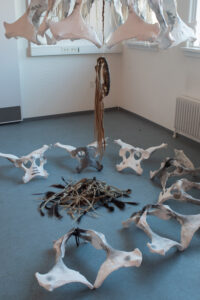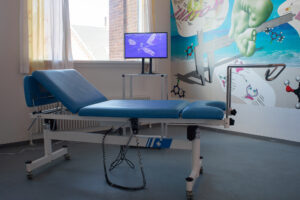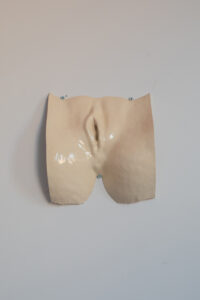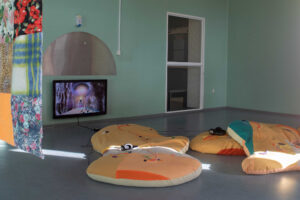By Miriam Katz, The visual artist #4 2022
With the newly established National Center for Art and Mental Health, Denmark has for the first time got a public, health professional body that focuses exclusively on the role of art in creating well-being, hope, community and care for people with mental disorders. All based on an equal meeting between psychiatric users, health professionals and artists.
Birgit Bundesen, senior doctor in psychiatry, sits side by side with her patients and writes, reads, draws, cuts, sews and paints when the art groups gather at the National Center for Art and Mental Health. Here, professional artists guide the participants in how they can use, among other things, visual arts and fiction methods. Together they create images and texts, listen to each other and talk about what is at stake in the works.
"One day I had written a really sad autumn text. Afterwards, one of the patients came up and patted me on the shoulder and said, 'I know how it is to be so sad. But remember, it's always spring again'. For a moment he had forgotten that I was the doctor. I was just a fellow human being who could be comforted a little. And it actually happens quite often in our art groups," says Birgit Bundesen, when the visual artist meets her in the center at the former Sankt Elisabeths Hospital, which, in addition to the newly established Center for Art and Mental Health, also houses four of the Psychiatric Center Amager's outpatient teams.

Signe Johannessen, Deposition for Recovery, 2021, from the exhibition M/OTHER. PHOTOS Amanda Bødker
Birgit Bundesen emphasizes that although the doctor-patient roles soften a little in the centre, she does not stop being the doctor. She is very aware that she has a responsibility and a power that the patients do not have.
"What we are trying to make happen here is a renegotiation of the roles of doctor-patient, healthy-sick, powerful-powerless. And art can open new spaces where we dare a little more. The fact that we jointly participate in the artistic processes opens up a softening of structural roles and makes the space safer," says she, who is not a supporter of the concept of safe spaces. Instead, she calls it brave spaces:
"We believe that changes happen where opportunities are open, and they do that in art. But it is not only positive, it can also sometimes hurt and be dangerous to work with art. That is why we are very concerned with creating a safe, creative space, a so-called holding environment. We call it a 'tender' space, understood as a space that can go both ways, and where we show courage and willingness to engage in dialogue with people who are different from ourselves. It also requires that the doctor dare to move out of his coat and is willing to enter into general human relations with his patients. Even though I am a doctor, like the other participants in the group, I feel uncertain when I have to write a text. Does the teacher now think I'm stupid? Will the others laugh at me when they read my text? But I am not naive and think that now we are all equal. I am, of course, aware that I have the healthcare expertise and, for example, also get a high salary for being here, which psychiatric users do not, she states.
Art opens up new spaces
In the spaces created by art, the participants are free to be something other than their diagnoses and – in the case of the therapists – their professions.
"Art sets some clear rules of the game, which we have in common, and which are the same from time to time. Here we don't ask each other about illness or what we do in everyday life. We work exclusively with the aesthetic idiom, and the participants get to know each other through our aesthetic signatures in the works. 'Ah, you're the one who writes with many colours', or 'you're the one who senses a lot with your toes'. Then suddenly you are not a person who is insane, but someone who writes in a certain way and leaves a special artistic mark," says Birgit Bundesen, who began working with fiction writing groups back in 2017 at the youth psychiatric section of the Psychiatric Center Amager, where she is a senior physician.
“I could see that we needed more and new ways of meeting patients. Offers that suit those who do not benefit sufficiently from the treatment we can otherwise provide, and who are therefore often hospitalized again and again," she says.

Mary Maggic, Genital (*) Panic, 2020, from the Exhibition M/OTHER. PHOTOS Amanda Bødker
"In the beginning it was very hands-on, we sat on cardboard boxes and talked about our texts together with some writers whom I know personally. But I saw great potential, and then it grew from there," says she, who herself studied literature before she trained as a doctor.
"Literature has been a natural way into psychiatry for me, because fiction can be a form of simulator where you learn to put yourself in someone else's place. In art and literature, you experience how other people's world looks and feels. As a doctor, you must be able to do the same: move out of yourself and into another body and the world and understand what the problem is. Not only what I think the problem is, but also what the patient thinks the problem is. And it's not always the same. If we don't figure it out, we easily waste each other's time and the patient doesn't get better. Art can open up new conversations, where we meet in different and more equal ways than what is usually done in psychiatry.”

Mary Maggic, Genital (*) Panic, 2020, from the Exhibition M/OTHER. PHOTOS Amanda Bødker
For Birgit Bundesen, medical science is first and foremost a humane, interpersonal discipline: "The ability to connect and relate to another person is a crucial clinical ability. Art can help create connections between nervous systems, connections between people and between people and works," says she, who in 2019 established the Association Center for Art and Mental Health together with a number of capacities from both psychiatry, the arts and the world of research.
New support for art in psychiatry
The focus was on including art and artists in the course of treatment, both during and after hospitalization in psychiatry. And this year, the association's work was anchored in the National Center for Art and Mental Health, which now has a finance law grant and support from both the Velux Foundation and the Obel Family Foundation.
Birgit Bundesen sees the fact that in these years there has been greater support for bringing art into psychiatry as an expression of a growing recognition of the huge, global social problem that mental disorders pose - and which we have to get better at preventing and process.
"We need some new, intelligent spaces where we think together, learn something new and learn from each other. Without it being about performing or having to take an exam afterwards. We are trying to create a different space, which is not a hospital, but which is not a hospital either. The word hospital comes from the word hospice, which means hospitality, and we are working on a renegotiation of the hospital as a hospitable place where we focus on something other than medical treatment. This does not mean that we are against medicine, but for some patients medicine does not have the desired effect, or it has too many side effects, and we must also be able to offer them courses that help them further.”
There is a need to create more bridges between psychiatry and the surrounding community if there is any hope of reducing mental suffering in the population, she believes. And art is one of those bridges.
"In our art groups, there is an opportunity to play and learn something new in a safe space. It is a form of self-care that requires us to park what we have learned about constantly optimizing ourselves, competing and being better all the time. Being connected to the thinking that pervades the perception of the individual in late-capitalist society can be incredibly rewarding. It's a mindset that helps make people sick," says Birgit Bundesen, who years ago experienced for herself what is possible when psychiatry works out during an extended stay at a closed, forensic psychiatric ward at a hospital in Switzerland. from a different, more holistic mindset.
Important eye openers
"There, the patients have access to, among other things, art workshops, horticulture and stables. You can train as a metalsmith while you are in hospital, or work in the hospital kitchen. As soon as you are fit enough to participate in an activity, you are put to work. Art, craft and social communities are integrated into the treatment, and the therapists themselves participate, together with the patients. In Swiss civil society, there is also great openness to, for example, taking people on internships when they are discharged from a psychiatric ward. It made a big impression on me to see that when you turn to the healthy side of patients, people can often do a lot more than you think," she recalls.

Nanna Lysholt Hansen & Stathis Tsemberlidis, Dear Daughter/Sen_sing_Inannainanna (Russ, Shiva, Klein), 2021, from the Exhibition M/OTHER. PHOTOS Amanda Bødker.
"There is always a sick side and a healthy side, and we need more services in psychiatry that cater to people's healthy side. For example, it has been a huge eye-opener for me to see young people who may have been hospitalized for ten months without wanting to say a single word to me in the doctor's office, who suddenly open up and can freestyle and write complicated, three- led rhymes à la Eminem when they attend one of our workshops with a professional rap musician. I perceived them as completely closed down, but they had a large, living inner world that I did not have access to, simply because I did not address it.”
If psychiatry only addresses the sick side, there is a risk that the illness will be frozen in an all-dominant narrative, as an identity that can be difficult for the patient to break out of, Birgit Bundesen believes. The exact opposite happens in the art groups. Here you are free to be anything other than your illness. And the artists who lead the centre's participant-focused art groups are a mixed crowd, she says:
Artistic work, not art therapy
"The artists we work with have in common that they themselves use their art to master life. At the same time, it is important to emphasize that it is not art therapy that we conduct in the groups. We train the artists not to go into the content, they are not therapists, and there is always a healthcare co-therapist present. The artist has the artistic expertise and controls the artistic processes. We emphasize that the artists master the aesthetic style and can put a sober distance to the content of the works. The artists must guide the participants in looking at the work on art's own terms. We are interested in the voice of the work, and in the work as something other than the person who creates it. The work is not me, I must lie, fabricate and invent things. We don't go in and check: Was it also like this in your childhood, as you write in your text, or where is your trauma in this picture. We are not looking for motifs, but present the material as an aesthetic product, which you can talk about in a completely different way than if it were your own experiences that you presented. That distance is protective and makes people braver,” she says.
Being a skilled artist does not necessarily mean that you are good at 'holding the room' and being a good teacher for the participants in the centre's art groups.
"You have to stand very strongly in your own artistic practice and have the ability to reflect on it. And you must be a clear professional and artistic authority. Some of the artists we work with have dual expertise because they themselves have experience with psychiatry. In this way, they become a kind of role models that the participants can look up to and see that you can have a nice life, even if you have a mental illness. It gives hope. And it helps to build a culture where we de-dramatize being mentally ill. It doesn't have to be shameful or shut down all conversation in the group if one of the participants has a bad day and has to leave the room for a while. We train our artists to be blunt about mental illness, but it's also not like we sit and cry about it together. It is just a natural part of the space that we have to navigate.”
Artists have special expertise
Fair pay and working conditions have been central to the centre's collaboration with artists right from the start. When you are associated with the center as an artist, you receive a good salary, but are also expected to share your knowledge, receive supervision and participate in the research team's work.

Loup Riviére, Armes Molles / Soft Weapons, 2021 and Elisabeth Kiss, Hvem Bær Dig?, 2021, Tabita Rezaire, Sugarwalls Teardom, 2017, from the Exhibition M/OTHER. PHOTOS Amanda Bødker
"For example, we ask the artists to sit in their colleagues' art groups, so that we learn from each other. Also when things go wrong, which they do all the time, because we are dealing with people and emotions here. It is a learning process for all of us. We are concerned with how we can get the positive 'greenhouse effects' that we see occurring in the closed environments of the art groups to sprout further in the participants' lived lives outside of psychiatry. Therefore, the researchers associated with the center follow the work of the art groups closely. They are doing a large, scientific study that tries to identify what effect art has on the participants in both the short and slightly longer term. And the artists sit in on all of the research team's meetings and contribute their expertise."
Already this spring, the center will publish a 2-volume work on the publishing house KLIM, where concepts, exercises and designs for the work in the writing groups are described, so that the work with art can hopefully spread to other places in psychiatry. "We experience very concretely that artists can contribute positively in our field, so I hope that others can use our experiences," says Birgit Bundesen.
"The passion for art and the way the artists see the world, we think, is a special way of being in life. We are trying to find out if it is something the artists can teach others. Whether you can use art to establish spaces in life that dare to go against the common attitudes and expectations of how one should be and what a good life looks like.”
Art has a resistance to normative notions, and this is a strength that is particularly relevant in psychiatry, she believes.
"When you have been chronically out of step with the so-called normality, then art is a platform where there is a higher ceiling and perhaps further frameworks for when you judge each other inside and out. Perhaps it can actually be an advantage to be a little eccentric, which after all means to be displaced from the norm. So we try to take advantage of the position that both the patient and the artists have: To be a little outside, or a little out of step with the concept of normality and to dare to stand next to normality – on purpose.”